Bert's Town - Part 05 - The Birthplace Museum
w/e 28 June 2009
All this week's pictures were taken
with a Kodak DX6490

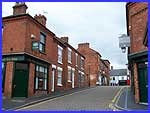 At
the end of Part 04 we had reached D H Lawrence's birthplace in
Victoria Street (left) and I had hoped to start this next part
with perhaps a couple of shots inside the Birthplace Museum before
continuing along the Blue Line Trail but we found so much of
interest that I've devoted the whole of this part to our visit.
Thanks are due to Broxtowe Borough Council for allowing me to
take At
the end of Part 04 we had reached D H Lawrence's birthplace in
Victoria Street (left) and I had hoped to start this next part
with perhaps a couple of shots inside the Birthplace Museum before
continuing along the Blue Line Trail but we found so much of
interest that I've devoted the whole of this part to our visit.
Thanks are due to Broxtowe Borough Council for allowing me to
take 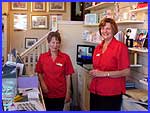 photos inside the
museum and to the staff working there, especially to Kath (the
lady on the left in this picture) who showed us round and shared
her vast knowledge about the Lawrence family making the visit
so informative and interesting. One piece of information that
is not commonly known is that Bert was christened David Herbert
Richards Lawrence but dropped the "Richards" and as
we do know, preferred to be called Bert. School parties often
tour the museum but we can heartily recommend a visit to all
ages. photos inside the
museum and to the staff working there, especially to Kath (the
lady on the left in this picture) who showed us round and shared
her vast knowledge about the Lawrence family making the visit
so informative and interesting. One piece of information that
is not commonly known is that Bert was christened David Herbert
Richards Lawrence but dropped the "Richards" and as
we do know, preferred to be called Bert. School parties often
tour the museum but we can heartily recommend a visit to all
ages.
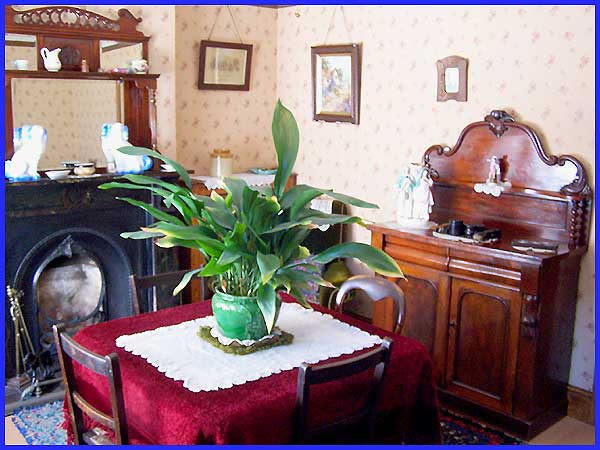
The museum and exhibition centre actually occupies two adjacent
properties but connecting doors have been installed between them.
The first room we looked at was the front room or parlour of
the former home of the Lawrence family. Furnished in the style
of the period and still illuminated by means of a gas light,
the room contains a piece of furniture that actually belonged
to the family. The cabinet on the right in the image above reflects
the taste of Bert's mother whose upbringing showed she favoured
quality items of furniture. The parlour was not for everyday
use and right up until the 1960s and perhaps even beyond, it
was only used on special occasions in many similar houses in
the country. The chenille tablecloth with a lace mat and potted
aspidistra was also a required 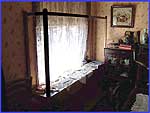 feature in parlours. feature in parlours.
We know that Lydia Lawrence, Bert's mother supplemented their
income by selling haberdashery displayed in the front room window
and this has been recreated in the museum. Customers though would
not have been allowed into the room or even served at the front
door but would have had to go to the back door to complete their
transactions. Lydia's Kent accent and her middle class background
set her apart from the local population and her business venture
was not a roaring success by any means.
|
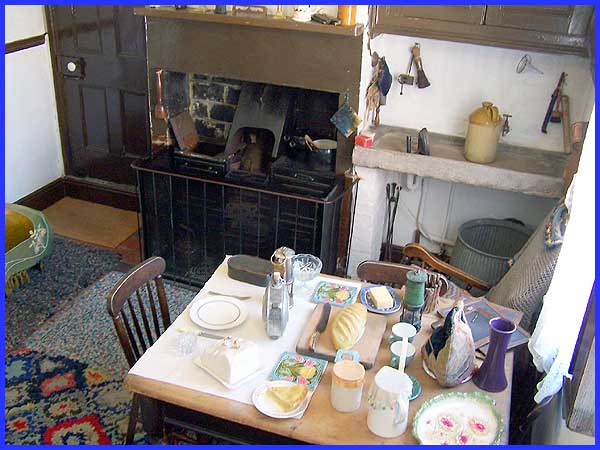
The back room of the house was the main living area and served
as a dining room, lounge, kitchen and even bathroom when water
heated in the coal-fired range would be used for all the family
to take their turn in a tin bath (that usually hung from a nail
in the yard outside) in front of the fire. There was no running
water in the house; all water had to be obtained by using a pump
outside and was used sparingly. Note the shallow sink on the
right of the picture. The range was also were the cooking was
done and flat irons heated before newly washed clothes were pressed
on the kitchen table. In many homes like this, miner's clothes
would be draped to dry in front of the fire an a daily basis.
In the museum there are examples of Davy lamps on the table as
well as a water bottle and a "snap" tin for the miner's
victuals. The door on the left of the picture leads to the yard
outside.
|
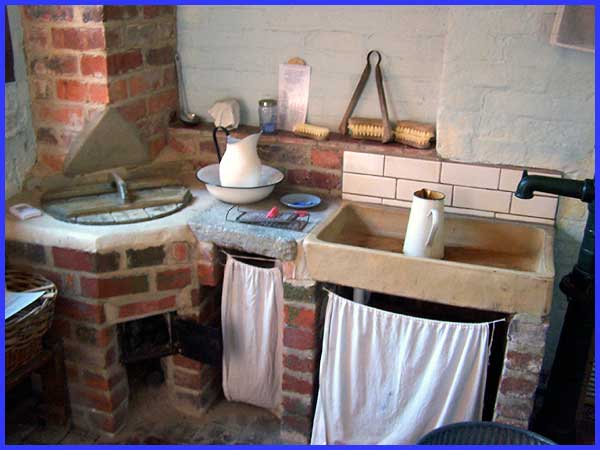
Across the yard are the outside toilets and also the washroom.
This particular washroom was moved to the museum when a nearby
property was modernised and was reconstructed here numbered brick
by numbered brick. Our guide Kath, told us that many visitors
to the museum said that many of the exhibits like this made them
feel old as they could remember similar rooms in their lifetime.
I spent the first twenty two years of my life in a two up, two
down cottage and can easily recollect when my parents had a copper
in the corner of the kitchen removed. Features like this were
common until the 1960s when the austere post war years were replaced
by more affluent times and people could afford to modernise their
properties. Seeing this washroom though just illustrated to me
how far we have come as a society in the last forty or fifty
years and just what a hard life it was in this mining community
in Bert's time.
|
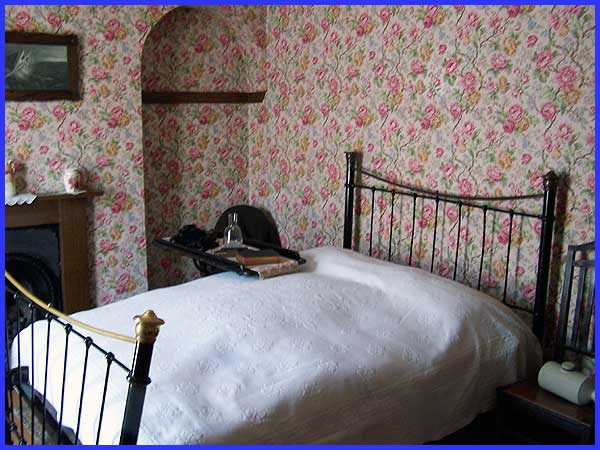
Upstairs the front or main bedroom contains a second piece of
furniture that belonged to the Lawrence family. Although not
in this house, the table that fits over the bed was used by Lydia
Lawrence. She died just as Bert's first novel, The White Peacock
was being published and the story goes that Bert rushed one of
the first copies of the book to his dying mother. Although she
probably did not read it, it is quite possible that it came to
rest on the table. Little anecdotes like this certainly bring
history to life.
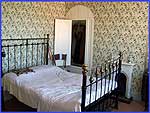 The second
bedroom (right) would normally be used in Victorian times for
the young girls in the family. The wallpaper in this room is
authentic to the period scraps having been found in the cupboard,
dated and reproduced and to be honest it would not look out of
place today. The boys of the Victorian families would usually
sleep in the attic and the museum has also recreated a room in
the style of the time. However as the Lawrence family left this
property for The Breach in 1887 before Bert was two years old
it is likely that he would still be sleeping with his parents
in the main bedroom. The second
bedroom (right) would normally be used in Victorian times for
the young girls in the family. The wallpaper in this room is
authentic to the period scraps having been found in the cupboard,
dated and reproduced and to be honest it would not look out of
place today. The boys of the Victorian families would usually
sleep in the attic and the museum has also recreated a room in
the style of the time. However as the Lawrence family left this
property for The Breach in 1887 before Bert was two years old
it is likely that he would still be sleeping with his parents
in the main bedroom.
|
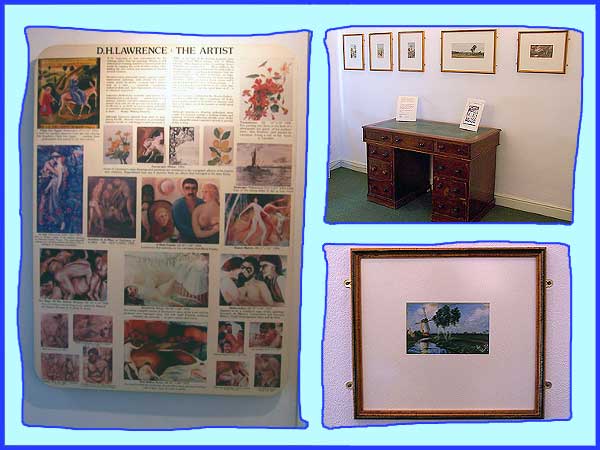
As on the ground floor a connecting door has been installed on
the upper floor between the two properties and this allows access
to the exhibition centre at the museum. Here there is a room
showing a ten minute video and in another room is a collection
of watercolours by DHL. Although best known for his writings
he was no mean artist and I was particularly taken with his "Landscape
With Windmill" picture (bottom right). The desk (top right)
is on loan from the Nottinghamshire County Council and is the
late Victorian pedestal desk used by Bert when he worked briefly
for J. H. Haywood on Castle Gate, Nottingham about 1901 (see
Historic Nottingham series Part 9). The room
also contains a couple of information boards about Bert's artwork
including the one pictured above about his more controversial
works which now reside overseas following a 1929 showing in London
when they were seized by the police as "obscene" and
were moved to prevent them being destroyed.
|
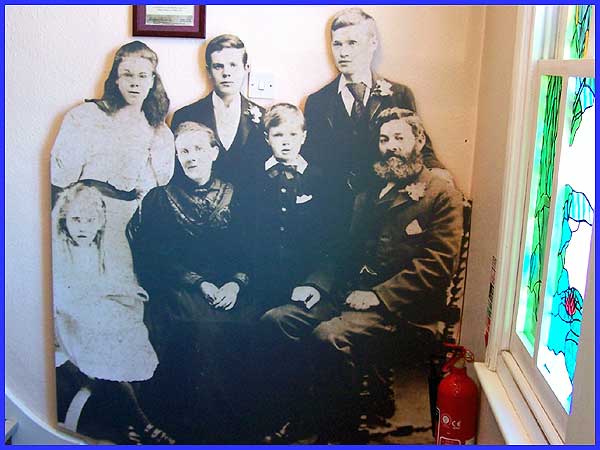
The landing in the exhibition area is dominated by a reproduction
of a photo of the Lawrence family. With Bert from left to right
are his older sister and brothers, Emily, George and Ernest at
the back and in front his younger sister Ada, mother Lydia and
father Arthur. The picture from 1895 which would make Bert about
ten years old was taken by Phillips and Freckleton at their premises
in the Market Place, Nottingham. By that time the Lawrences had
moved again to Walker Street in Eastwood and the excursion was
a joint venture with their neighbours the Thurlbys. The women
and children made the journey in a carrier's cart following the
men who had set off earlier on foot and true to form had used
the outing as an excuse for a pub crawl.
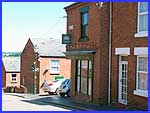
Leaving the exhibition, we returned downstairs to pass once again
through the main entrance to the museum which also serves as
a gift and souvenir shop and out onto Victoria Street. The shop
in Lawrence's time had been a greengrocer's and opposite now
is another shop that in honour of the author is called the White
Peacock Tea Shop (right). We returned up Victoria Street to Nottingham
Road and in the next part will continue along the Blue Line and
Literary Trails in search of more of the D. H. Lawrence connection.
|

